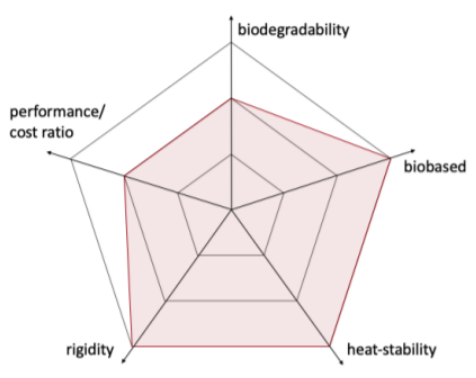Knowde Enhanced TDS
Identification & Functionality
- Chemical Family
- Fillers Included
- Polymer Name
- Technologies
Features & Benefits
- Materials Features
- key Characteristics
- Injection molding grade
- Biopolymer compound, mineral filled
- Can be blended with bamboo powder (B), rice husk (R), coffee husk (C), wheat straw (W) and wood powder (H)
- High rigidity
- Can be crystallized/annealed to be heatstable up to 110°C
- Biodegradable in controlled conditions (e.g. industrial compost) according to DIN EN 13432 / ASTM D6400
- Easier to process than virgin PLA/cPLA
- Food contact safe
- Dishwasher-ok / microwave-ok
- Global availability.
Bioblend LT25B (B/R/C/W/H) is a modified PLA-blend. The grade is enhanced with a blend of natural mineral fillers. Bioblend LT grades are easy to process and prepared for a fast and efficient postprocessing crystallization/annealing process. The material can additionally be blended with bamboo powder, rice husk or coffee husk, wheat straw and wood powder to support a natural look.
Bioblend LT25B (B/R/C/W/H) is compostable/biodegradable (microbial and enzymatic degradation) in the targeted disposal environment; it is biodegradable in controlled (e.g. industrial compost facilities) conditions according to EN 13432 (for Europe) and ASTM D6400 (for the USA). Bioblend LT grades offer a significant reduction in carbon footprint compared to fossil-based plastics. The grades exhibit excellent strength and stiffness properties as well as a good flow combined with improved elongation values. An increased rate of crystallization allows an annealing to a heat-stable temperature of 110 °C (HDT-B) and above.
Part wall-thickness shall be greater than 1.5 mm.
- key Characteristics

Applications & Uses
- Applications
- Plastics & Elastomers End Uses
- Plastics & Elastomers Processing Methods
- Applications
Typical applications where Bioblend LT25B (B/R/C/W/H) is used for are:
- Consumer goods (e.g. pens)
- Kitchen ware (e.g. season use cutlery, cups, boxes, trays)
- Toys
- Personal care (e.g. tooth brush handle, soap box)
- Rigid packaging (e.g. make-up boxes)
- Beauty (e.g. cosmetic brushes)
- Sports & outdoor
- Process Guidelines
Bioblend LT25B (B/R/C/W/H) can be processed on conventional injection molding equipment. The material is sensitive to moisture and high temperatures (above 190°C); high shear rates shall be avoided. The matrial needs to be dried before processing. Do not keep the material in the heated barrel longer than 5 – 8 minutes; the material is prone to degrade.
- Drying
Dry the material for a minimum of 4 - 6 hours at 80o C. A moisture content of less than 0.07% (700 ppm) is required / less than 0.10% (1000 ppm) is recommended. Avoid exposing the material to atmospheric conditions after drying; process immediately.
- Injection Moulding Start-Up
- Vacuum-out/clean hopper and air-suction system to avoid contamination.
- Clean/purge the barrel. 3. Once the barrel has been cleaned, reduce barrel temperatures to the right set points (see next section).
- Introduce the compounds into the barrel only after all barrel temperatures are at target set points. The material cannot enter into the barrel when temperatures are above 190°C in any section!
- Make sure that the mold is heated up to a temperature of around 55°C. Bioblend LT grades cannot be processed on cold molds.
- Start with a moderate holding pressure and keep it applied for long initially. Bioblend LT grades have a slow solidification. Sink marks throughout the part are a result of a too low holding pressures that are applied for a too short time. Carefully increase holding pressure and prolong holding time until sink marks disappear.
- Start with long cooling times before opening the mold: tcooling (in sec) > biggest wall-thickness (in mm) x 10
- After start-up, the injection molding process shall be optimized step-by-step to industry relevant process paramaters.
Properties
- Physical Form
- Typical Properties
- Processing Information (Injection Molding)
| Value | Units | Test Method / Conditions | |
| Density | 1.3 | g/cm3 | — |
| Melt Flow Rate (190°C/2.16 kg) | min. 70.0 | g/10 min | ASTM D1238 |
| HDT-B (0.46 MPa) | 54.2 | °C | ASTM D648 |
| Tensile Strength (50 mm/min) | 51.7 | Mpa | ASTM D638 |
| Flexural Strength | 65.2 | Mpa | ASTM D790A |
| Flexural Modulus (1% secant) | 5.3 | Gpa | ASTM D790A |
| Elongation at Yield (50 mm/min) | 7.5 | % | ASTM D638 |
| Elongation at Break (50 mm/min) | 31 | % | ASTM D638 |
| IZOD Notched Impact Strength (at 23°C) | 31.5 | J/m | ASTM D256 |
| Mold Shrinkage | 0.45 | % | — |
| Density (annealing, 5 minutes at 130°C) | 1.3 | g/cm3 | — |
| HDT-B (0.46 Mpa, annealing, 5 minutes at 130°C) | min. 125.0 | °C | ASTM D648 |
| Tensile Strength (50 mm/min, annealing, 5 minutes at 130°C) | 37.3 | Mpa | ASTM D638 |
| Flexural Strength (annealing, 5 minutes at 130°C) | 56.9 | Mpa | ASTM D790A |
| Flexural Modulus (1% secant, annealing, 5 minutes at 130°C) | 5.1 | Gpa | ASTM D790A |
| Elongation at Yield (50 mm/min, annealing, 5 minutes at 130°C) | 7.5 | % | ASTM D638 |
| Elongation at Break (50 mm/min, annealing, 5 minutes at 130°C) | 9.5 | % | ASTM D638 |
| IZOD Notched Impact Strength (23°C, annealing, 5 minutes at 130°C) | 29.8 | J/m | ASTM D256 |
| Value | Units | Test Method / Conditions | |
| Hopper Temperature | Room Temperature | — | — |
| Feed Zone Temperature | 180 | °C | — |
| Compression Zone Temperature | 185 | °C | — |
| Metering Zone Temperature | 190 | °C | — |
| Nozzle Temperature | 185 | °C | — |
| Mould Temperature | 50-60 | °C | — |
| Screw Speed | Low – Medium | — | — |
| Injection Pressure | Low | — | — |
| Holding Pressure | Long | — | — |
| Injection Speed | Slow | — | — |
| Cooling Time | Long | — | — |
Regulatory & Compliance
- Certifications
Bioblend LT25B (B/R/C/W/H) has obtained the following certifications:
Food contact safe (TÜV Rheinland)
- German §31 LFGB (Lebensmittel-, Bedarfsgegenstände- und Futtermittelgesetzbuch)
- European Regulation (EC) No 1935/2004
- Commission Regulation (EU) No 10/2011
Degradation tests / certificates (DIN CERTCO, Certificate Registration No. 7W0349/9K0067)
- Biodegradation in controlled conditions Europe EN 13432:2000-12
- Biodegradation in controlled conditions Europe US ASTM D640
Storage & Handling
- Storage
Keep the material tightly closed in a dry and cool place. Keep away from heat and sources of ignition and avoid exposure to moisture, dampness. Do not stor outdoors. Use material within 6 month after delivery.

